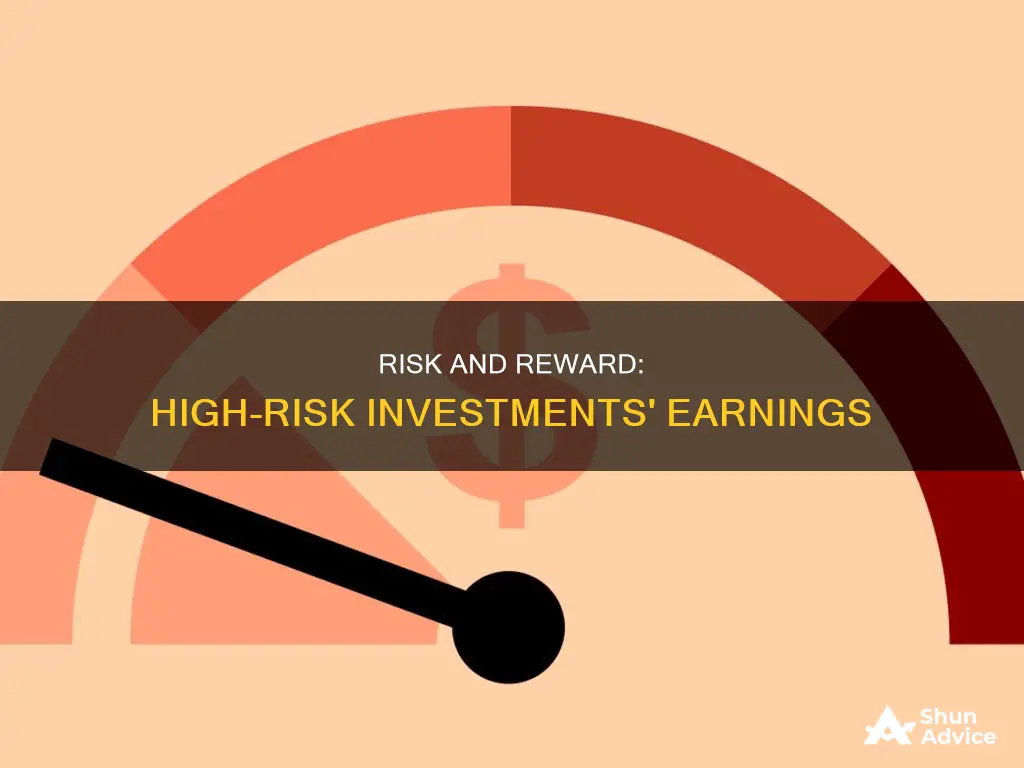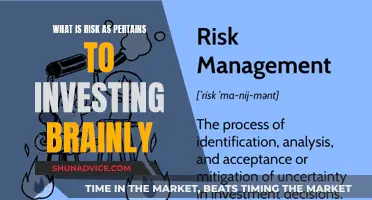
Risk is fundamental to investing, and while it is not a well-defined or quantifiable idea, it is generally understood that the higher the risk, the higher the potential returns. High-risk investments can lead to significant returns, but they can also result in substantial losses. These investments are typically characterised by a large percentage chance of loss of capital or underperformance, or a high chance of a devastating loss. Examples of high-risk investments include initial public offerings (IPOs), real estate investment trusts (REITs), and venture capital. On the other hand, low-risk investments offer smaller but more consistent returns and are seen as safer bets. They provide peace of mind to investors and help balance portfolios, protecting against market volatility. Examples of low-risk investments include bonds, high-yield savings accounts, and money market accounts. Ultimately, the choice between high-risk and low-risk investments depends on an investor's risk tolerance, financial situation, and goals.
| Characteristics | Values |
|---|---|
| Returns | High-risk investments can lead to significant returns but it's never a sure thing. |
| Risk | High-risk investments can result in a potential payout, but no one can predict which investments will soar and which will underperform. |
| Investor Profile | High-risk investments are more suitable for experienced investors, while those just beginning their investing journey might prefer to start off with low-risk investment alternatives. |
| Investor Behaviour | High-risk investing should only be done by experienced investors. |
| Investor Allocation | Don't put more than 10% of your net assets in high-risk investments. |
| Investor Mindset | Be prepared to potentially lose all of what you invested. Only invest what you can afford to lose. |
| Investor Due Diligence | Be wary of scams and trade on a trusted platform. Check for regulatory protection. |
What You'll Learn

Initial Public Offerings (IPOs)
IPOs are considered high-risk because there is a large percentage chance of loss of capital or underperformance. Most IPOs fail to generate significant returns or any returns at all. However, some IPOs attract a lot of attention that can skew valuations and professional judgments, while others are less high-profile and can offer investors the chance to purchase shares while a company is severely undervalued, leading to high short- and long-term returns.
For example, Twilio Inc. (TWLO), a cloud communications company that went public in June 2016, raised $150 million at an IPO offer price of $15 per share. By its third day of trading, Twilio's share price had increased by 90%, and by mid-December it was up 101%.
IPOs can be an attractive investment opportunity because they are often discounted to ensure sales, making them even more appealing to buyers. However, the offering price announced ahead of the IPO is usually reserved for institutional investors, employees, and investors who meet specific eligibility requirements. Therefore, individual investors may have to wait for the secondary market, where securities are traded after the IPO, to purchase shares.
When considering investing in an IPO, it is important to keep in mind that newly public companies are often categorized as high-risk and volatile due to their lack of a proven track record of operating in the public domain. Reliable financial information about a company issuing an IPO may be difficult to obtain, making it challenging to properly assess the company's financial history and prospects.
Overall, IPOs offer a combination of opportunities and challenges. While some IPOs have resulted in significant gains for investors, others have failed to produce favourable returns. It is crucial for investors to carefully consider the risks and conduct thorough research before investing in IPOs.
Invest Wisely: Smart Home Improvement Choices
You may want to see also

Real Estate Investment Trusts (REITs)
REITs were created by a 1960 law to make real estate investing more accessible to smaller investors. They are required to meet certain standards set by the IRS, including distributing at least 90% of their income to investors in the form of dividends.
REITs can be categorised into three types: equity REITs, mortgage REITs, and hybrid REITs. Equity REITs operate like a landlord, collecting rent and managing properties. Mortgage REITs, on the other hand, deal with debt securities backed by properties, such as mortgages. Hybrid REITs combine strategies from both equity and mortgage REITs.
REITs can be further divided into publicly traded REITs, public non-traded REITs, and private REITs based on their investment holdings. Publicly traded REITs are the most common and liquid, traded on exchanges like stocks. Public non-traded REITs are less liquid and more stable, while private REITs are generally exempt from SEC registration and carry higher risks.
REITs offer several advantages, including steady dividends, high returns, liquidity, and lower volatility compared to traditional stocks. However, they also come with drawbacks such as heavy debt, low growth and capital appreciation, and tax burdens for investors.
When investing in REITs, it is recommended to start with publicly traded REITs, diversify across REIT categories, and consider using REIT funds or real estate index funds for further diversification.
India's Domestic Investment: Measuring the Metrics
You may want to see also

Foreign Emerging Markets
However, there are several risks associated with investing in foreign emerging markets. One significant risk is foreign exchange rate risk. Returns on foreign investments in stocks and bonds are typically produced in the local currency. As a result, investors will have to convert the local currency back into their domestic currency, and currency fluctuations can impact the total return of the investment.
Another risk is the difficulty of raising capital in emerging markets due to poorly developed banking systems. This can prevent firms from accessing the financing they need to grow their businesses, and the high cost of capital can limit the number of profitable projects a company can undertake.
Emerging markets may also have lax insider trading restrictions, making them more susceptible to market manipulation and speculation. These markets are also generally less liquid, resulting in higher broker fees and increased price uncertainty.
Additionally, emerging markets may have poor corporate governance, with management or the government having a greater voice in the firm than shareholders. This can reduce the incentive for management to perform well.
Finally, emerging markets are more susceptible to political risks, such as the possibility of war, tax increases, changes in market policy, and inability to control inflation. These factors can contribute to major political instability and even civil war, which can have a significant impact on the economy and industry.
Gains and Losses: Equity Investments Control Exemptions
You may want to see also

High-Yield Bonds
- Diversification: High-yield bonds typically have a low correlation to investment-grade fixed-income sectors, such as Treasuries and highly-rated corporate debt. Adding high-yield bonds to a portfolio can enhance diversification and help reduce overall portfolio risk.
- Enhanced current income: High-yield bonds offer significantly greater yields than government bonds and many investment-grade corporate bonds. The average yields vary depending on the economic climate, generally rising during downturns when default risk is higher.
- Capital appreciation: An economic upturn or improved performance of the issuing company can positively impact the price of a high-yield bond.
- Equity-like, long-term return potential: High-yield bonds tend to respond similarly to equities in the overall market environment, leading to similar return profiles over a full market cycle. However, returns on high-yield bonds are less volatile due to the larger income component, providing added stability.
- Relatively low duration: High-yield bonds often have shorter maturities, typically issued with terms of 10 years or less, and are callable after four or five years.
In summary, high-yield bonds can be a lucrative investment option, offering higher yields than government and investment-grade corporate bonds. However, they come with a higher risk of default, and investors should carefully consider the potential benefits and risks before investing.
Smart Strategies to Turn $2K into $4K
You may want to see also

Venture Capital
VC investors tend to look for companies with high growth potential, a strong management team, a large potential market, and a distinctive product or service with a solid competitive advantage. They also seek companies that provide either a new solution or a disruptive way of attacking huge addressable markets.
Despite the potential for high returns, venture capital carries notable risks. One of the biggest is the drain that research and development can have on finances. Startups often need to test their solutions, and the bugs associated with downtime and failed software can lead to uneven or no revenue. This may require VCs to invest more money to keep the company afloat.
Another common risk is the technology itself. Patents may be challenged, or the technology may be stolen, copied, or "leapfrogged" by competitors. For example, BlackBerry's physical handset phones were challenged by Apple's iPhone, causing BlackBerry's global market share to drop from around 50% in 2009 to less than 3% in 2013.
Other risks include growth and personnel issues, where companies may not be able to find the capital, raw materials, or talent needed to maintain operations. There is also the risk of corporate theft of intellectual property and patent infringements.
To mitigate these risks, venture capitalists and the companies they invest in must have detailed plans on how the money will be used at each funding stage. VCs also construct a portfolio of investments across different sectors, stages, and geographies to diversify their risk. They expect that out of a typical portfolio of 10 to 20 investments, one or two will be "home runs," returning more than 10 times the initial investment.
A Beginner's Guide to Investing in India INX
You may want to see also
Frequently asked questions
Some examples of high-risk investments include:
- Initial Public Offerings (IPOs)
- Real Estate Investment Trusts (REITs)
- Venture Capital
- Foreign Emerging Markets
- High-Yield Bonds
- Penny Stocks
- Cryptocurrency
High-risk investments can result in larger financial gains compared to low-risk investments. They can also play a key role in long-term financial planning and help investors keep pace with inflation. Additionally, high-risk investments can provide an opportunity for investors to diversify their portfolios and accelerate wealth accumulation.
High-risk investments carry a higher possibility of significant financial losses. They often involve greater volatility and uncertainty, making it difficult to predict their performance. High-risk investments may also have lower liquidity, making it challenging to access funds once invested. These types of investments are generally more suitable for experienced investors with a higher risk tolerance.







